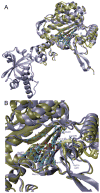A bacterial ortholog of class II lysyl-tRNA synthetase activates lysine
- PMID: 20580719
- PMCID: PMC2900529
- DOI: 10.1016/j.febslet.2010.05.036
A bacterial ortholog of class II lysyl-tRNA synthetase activates lysine
Abstract
Aminoacyl-tRNA synthetases produce aminoacyl-tRNAs, essential substrates for accurate protein synthesis. Beyond their central role in translation some of these enzymes or their orthologs are recruited for alternative functions, not always related to their primary cellular role. We investigate here the enzymatic properties of GenX (also called PoxA and YjeA), an ortholog of bacterial class II lysyl-tRNA synthetase. GenX is present in most Gram-negative bacteria and is homologous to the catalytic core of lysyl-tRNA synthetase, but it lacks the amino terminal anticodon binding domain of the latter enzyme. We show that, in agreement with its well-conserved lysine binding site, GenX can activate in vitro l-lysine and lysine analogs, but does not acylate tRNA(Lys) or other cellular RNAs.
Copyright 2010 Federation of European Biochemical Societies. Published by Elsevier B.V. All rights reserved.
Figures




Similar articles
-
Anticodon recognition and discrimination by the alpha-helix cage domain of class I lysyl-tRNA synthetase.Biochemistry. 2007 Oct 2;46(39):11033-8. doi: 10.1021/bi700815a. Epub 2007 Aug 31. Biochemistry. 2007. PMID: 17760422 Free PMC article.
-
Anticodon recognition in evolution: switching tRNA specificity of an aminoacyl-tRNA synthetase by site-directed peptide transplantation.J Biol Chem. 2003 Aug 15;278(33):30927-35. doi: 10.1074/jbc.M302618200. Epub 2003 May 22. J Biol Chem. 2003. PMID: 12766171
-
Aminoacyl-tRNA synthesis: a postgenomic perspective.Cold Spring Harb Symp Quant Biol. 2001;66:175-83. doi: 10.1101/sqb.2001.66.175. Cold Spring Harb Symp Quant Biol. 2001. PMID: 12762020 Review. No abstract available.
-
Essentiality Assessment of Cysteinyl and Lysyl-tRNA Synthetases of Mycobacterium smegmatis.PLoS One. 2016 Jan 21;11(1):e0147188. doi: 10.1371/journal.pone.0147188. eCollection 2016. PLoS One. 2016. PMID: 26794499 Free PMC article.
-
Lysyl-tRNA synthetase.Biol Chem Hoppe Seyler. 1995 Aug;376(8):451-72. doi: 10.1515/bchm3.1995.376.8.451. Biol Chem Hoppe Seyler. 1995. PMID: 7576245 Review.
Cited by
-
Identification of Genes Required for Growth of Escherichia coli MG1655 at Moderately Low pH.Front Microbiol. 2016 Oct 25;7:1672. doi: 10.3389/fmicb.2016.01672. eCollection 2016. Front Microbiol. 2016. PMID: 27826291 Free PMC article.
-
Identification and functional characterization of a novel bacterial type asparagine synthetase A: a tRNA synthetase paralog from Leishmania donovani.J Biol Chem. 2014 Apr 25;289(17):12096-12108. doi: 10.1074/jbc.M114.554642. Epub 2014 Mar 7. J Biol Chem. 2014. PMID: 24610810 Free PMC article.
-
Unusual domain architecture of aminoacyl tRNA synthetases and their paralogs from Leishmania major.BMC Genomics. 2012 Nov 14;13:621. doi: 10.1186/1471-2164-13-621. BMC Genomics. 2012. PMID: 23151081 Free PMC article.
-
The tRNA synthetase paralog PoxA modifies elongation factor-P with (R)-β-lysine.Nat Chem Biol. 2011 Aug 14;7(10):667-9. doi: 10.1038/nchembio.632. Nat Chem Biol. 2011. PMID: 21841797 Free PMC article.
-
Loss of elongation factor P disrupts bacterial outer membrane integrity.J Bacteriol. 2012 Jan;194(2):413-25. doi: 10.1128/JB.05864-11. Epub 2011 Nov 11. J Bacteriol. 2012. PMID: 22081389 Free PMC article.
References
Publication types
MeSH terms
Substances
Grants and funding
LinkOut - more resources
Full Text Sources
Other Literature Sources
Molecular Biology Databases

